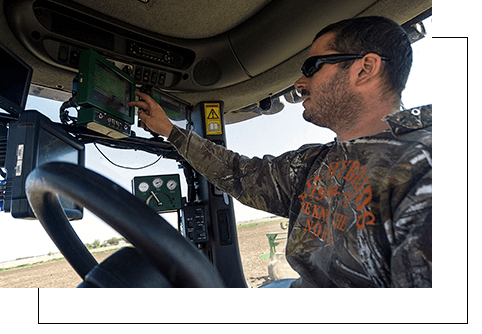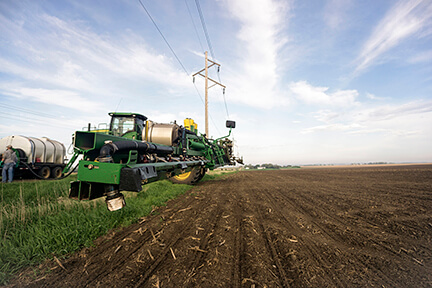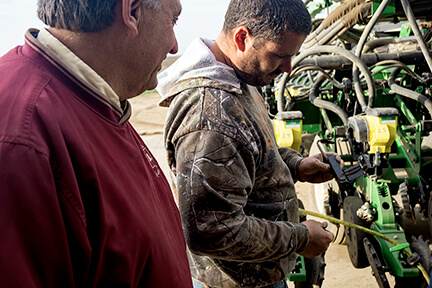
Healthy Soils for a Better Planet
Soil is one of our most precious resources. Farmers understand how important it is, and they’re using methods like reduced tillage and cover crops to build and maintain soil health on their farms.

Farmers today have a knowledge base and skill set that combines centuries of tradition with the most advanced digital tools ever known. As a result, modern agriculture has helped reduce the impact of farming on the environment and increased the amount of food being grown.
On any given day, farmers like Walt Bones and his family partners can be found studying commodities markets, consulting agronomic data about soil health and fertility, repairing advanced equipment like 36-row planters, communicating with local partners about nutrients and livestock feed, and taking the time to speak with the public about things like GMOs.
Bones is a fourth-generation farmer working the land his great grandfather homesteaded back in 1879, near Parker, South Dakota. The family has always run a diversified operation, like many in their region. In addition to farming nearly 7,000 acres of corn and soybeans, the Bones family participates in a local dairy cooperative and manages a beef cattle breeding operation. He manages the enterprise with his team of two brothers, a brother-in-law, and three nephews.
“What allows us to be diversified is the amazing collection of specialized skill sets our partners have,” says Bones.
His brother, Jim Bones, and nephew, Dan Bones, formulate the farming plan, selecting the hybrids1, crop protection products and nutrients for the year. His other brother, Steve Bones, joins nephew, Matt Bones, to handle maintenance and operate the equipment. Lyle Van Hove, his brother-in-law, is in charge of marketing and risk management. Lyle’s son, Mike Van Hove, is head of maintenance and also fabricates specialized tools and equipment as needed. Finally, their beef cow herdsman is Monte Plucker.
Some of the decisions they make are based on experience and tradition. Deciding when to plant, for example, involves keeping a close eye on the weather among other things, but the Bones family has learned over the years that there’s no replacement for simply walking the fields to determine if they’re ready. Excessive moisture is not good, because the tractor can get stuck. In addition to making sure the ground can withstand the weight (compacted soil hinders seed development), another key concern is making sure the seed delivery and nutrient applicator attachments on the planter aren’t clogged with mud.
Some of the decisions they make are based on experience and tradition. Deciding when to plant, for example, involves keeping a close eye on the weather among other things, but the Bones family has learned over the years that there’s no replacement for simply walking the fields to determine if they’re ready. Excessive moisture is not good, because the tractor can get stuck. In addition to making sure the ground can withstand the weight (compacted soil hinders seed development), another key concern is making sure the seed delivery and nutrient applicator attachments on the planter aren’t clogged with mud.
Once they make the decision to begin planting, the Bones operation relies on some of the most advanced technology available. His operation uses two 36-row planters, each capable of planting roughly 40 acres every hour. On a full day, his team can achieve between 800 and 900 acres of planting.
The tractors pulling those planters contain a staggering array of digital readouts. This winter, Matt Bones and Mike Van Hove, who operate the machines during planting, suggested their partners upgrade one of their planters with state-of-the-art sensors on each row. These sensors monitor the down pressure—required to maintain the ideal 2” planting depth for the seeds—by taking up to 200 readings per second and adjusting that pressure accordingly. This technology helps make sure each of the seeds that go into the ground has the best chance to reach its potential.
As planting commences, the challenges shift to planning and logistics. Bones and his team coordinate planting each morning, setting up the planters, loading them with seed and starter fertilizer, and filling replenishment trucks. Perhaps most importantly, Bones drives to the local cafe to buy lunch and dinner for his team of seven, then meets them in the field and delivers their meals.
“They only stop long enough for me to give them their food,” says Bones. “Then they go right back to it. They’re amazing.”


Other decisions have become far more dependent on precise science. Nutrient management, the practice of analyzing the soil and making fertility decisions, has become an extremely precise endeavor over the past couple decades, with the emergence of grid sampling and detailed analyses of soil fertility and nutrients.
Because their operation is diversified, and because they are situated among other livestock operations, Bones has access to organic nutrients in the form of cattle and swine manure. Before using these nutrients, however, they work with a local agronomist to analyze the nitrogen and phosphorous content in his soils. He then takes advantage of technologically advanced, environmentally sound earthen manure pits and pipelines for storing and transporting those nutrients.
Because their operation is diversified, and because they are situated among other livestock operations, Bones has access to organic nutrients in the form of cattle and swine manure. Before using these nutrients, however, they work with a local agronomist to analyze the nitrogen and phosphorous content in his soils. He then takes advantage of technologically advanced, environmentally sound earthen manure pits and pipelines for storing and transporting those nutrients.
They also use grid sampling, a method of soil testing that sections large tracts of land into 2-3 acre segments. This allows them to acquire a more precise understanding of smaller subsections of their fields, to determine which areas might need less fertilizer when the time comes.
Finally, they pay close attention to weather patterns before applying nutrients to their fields, taking care to avoid application before heavy rains. To minimize runoff after rains, those fields are bordered with grassy buffer strips, and located throughout the operation are patches of Conservation Reserve Program land set aside for wildlife habitat. This minimizes the possibility of nutrients moving into local waterways. All in all, maintaining soil health and water quality requires Bones and his partners to understand soil chemistry, nutrient chemistry, weather and climate patterns, and advanced application machinery.
The story of modern agriculture combines sophisticated knowledge, sophisticated technology, and sophisticated decision making. Even so, much of the success in any given year relies on factors that are out of the farmer’s control. Weather, the availability of local storage and processing options, and fluctuations in commodity prices can all have a drastic impact on a farmer’s year.


The story of modern agriculture combines sophisticated knowledge, sophisticated technology, and sophisticated decision making. Even so, much of the success in any given year relies on factors that are out of the farmer’s control. Weather, the availability of local storage and processing options, and fluctuations in commodity prices can all have a drastic impact on a farmer’s year.
As the saying goes, chance favors the prepared, so farmers work diligently to be as prepared as possible. In doing so, they can minimize the negative impact of chance and capitalize when opportunities present themselves.
Like many other farmers, the Bones operation continues to evolve with the industry, seeking ways to capitalize on their experience and knowledge while taking advantage of the tools and processes available to them.
Today’s farmers are truly sophisticated farmers. Imagine how sophisticated the next generation of farmers will be.
Related Articles

Soil is one of our most precious resources. Farmers understand how important it is, and they’re using methods like reduced tillage and cover crops to build and maintain soil health on their farms.

